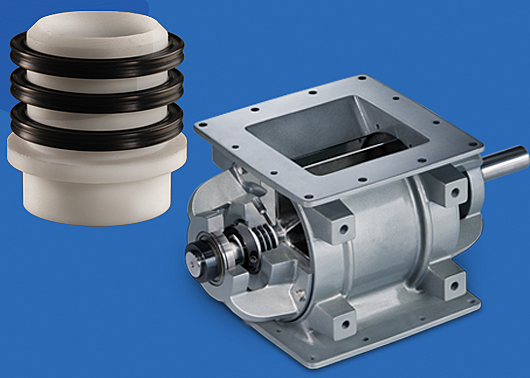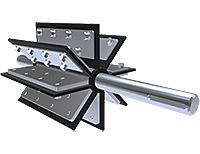
Heads up — we have a newer version of this blog with more up-to-date information. Check it out here!
Keep your valves compliant by replacing your seals
One seal, two seals, packing gland, shaft seal. The choices are seemingly endless for the types of seals that work with your rotary valves and airlocks.
And, just so you don’t have to go through the same dilemma of which seal to choose every time they need replacing (which they will), here’s your go-to-guide on rotary valve seals.
What is a shaft seal?
Shaft seals sit inside the stuffing box of your rotary housing. Their main function is to prevent material from moving from the rotor pockets, and out towards the outboard bearings. They also prevent contaminants from entering into your rotor housing. Once a shaft seal fails, it puts your bearings at risk for material build-up and failure. Not only this, your valve then becomes uncompliant with NFPA due to the increased risks of your materials building up and igniting.
Types of seals
Packing gland: The most common type of seal, but not necessarily the most cost effective or simple to replace. These are made from woven fibers and lubricant, and need to be manually pushed into the stuffing box. They generally have a lower lifespan than other types of seals.
Lip and quad seals: These have the same properties as packing glands, but instead use quad rings or lip gaskets as seal reinforcement. Because they use several layers or rows of seals, leaks only occur when the last row of the seal breaks down.
Teflon shaft seal: A sleeve-style shaft assembly that eliminates static electricity and reduces the friction force between its three, four lobed ring seals and the valve rotor shaft. A video demonstration of how it works can be seen here.
Mechanical seals: This type of pressurized seal generally uses air purges that are stronger than the force of the air pressure inside the rotary valve to keep materials away from the seal. Labyrinth air purge seals use scrolled channels to redirect any escaping products back into the rotor housing. Lantern ring air purge seals do the same, but without the rotating channels. Air purge seals allow you to measure air pressure and therefore easily detect if you have any seal leaks through pressure changes. These are often much more expensive, but will last a long time.
Seal maintenance and replacements
Depending on the material you’re conveying, your shaft seals will wear out and need replacing at different points. Aim to select seals that work well with your materials, and last as at least as long as your rotor tips.
As soon as your seals wear, it puts your bearings and rotor at risk of contamination, thus making your valve uncompliant with NFPA due to the risks of material build-up which could lead to an ignition source for deflagration. We have a kit that makes staying compliant easy with out of the box rotor, bearing and shaft seal replacements. You can find it here.


